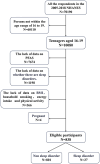Association between perfluoroalkyl and polyfluoroalkyl substances and adolescents' sleep disorders: NHANES 2005-2018
- PMID: 40444251
- PMCID: PMC12121506
- DOI: 10.3389/fnut.2025.1584281
Association between perfluoroalkyl and polyfluoroalkyl substances and adolescents' sleep disorders: NHANES 2005-2018
Abstract
Background: Previous research indicates that per- and polyfluoroalkyl substances (PFAS) can disrupt metabolism and neurological function via endocrine pathway interference and neuroinflammation. These effects may impair melatonin secretion and disrupt circadian rhythm regulation, suggesting potential links to sleep health. However, the impact of PFAS exposure on adolescent sleep remains unclear. This study examines the associations between PFAS exposure and sleep health indicators in U.S. adolescents.
Methods: Data from 838 adolescents who participated in the 2005-2018 National Health and Nutrition Examination Survey (NHANES) were analyzed to investigate the association between PFAS exposure and physician-diagnosed sleep disorders. Eight PFAS compounds were identified. Multivariate logistic regression models, restricted cubic spline (RCS) curves, Bayesian kernel machine regression (BKMR), and weighted quantile sum (WQS) regression were used to assess single, linear, and combined effects on adolescent sleep disorders.
Results: Negative associations were observed between adolescent sleep disorders and three PFAS compounds, specifically perfluorooctanoic acid (PFOA), perfluorooctanesulfonic acid (PFOS), and perfluorononanoic acid (PFNA). RCS analysis revealed a significant linear relationship (P for non-linear > 0.05). The BKMR and WQS models demonstrated a combined effect of PFAS exposure on sleep disorders, with PFOS demonstrating the most substantial contribution (effect size: 0.91). The stratified analysis revealed that PFOS exposure had a greater impact on females [odds ratio (OR): 0.54, 95% confidence interval (CI): 0.33-0.87] than males (OR: 0.50, 95% CI: 0.24-1.01), suggesting sex-specific differences in vulnerability.
Conclusions: Our findings indicate a negative correlation between specific PFAS and specific sleep disorders in adolescents, with PFOS being the dominant effect component in the PFAS mixture and stronger effects observed in females. However, due to the cross-sectional nature of the study, a causal relationship cannot be established. These results highlight the potential public health impact of PFAS exposure and the need to further investigate the underlying mechanisms and causal pathways in future longitudinal or experimental studies.
Keywords: NHANES; PFAS; PFOS; adolescents; sleep disorders.
Copyright © 2025 Gao, Gong, Lu, Gou, Lai, Luo and Yang.
Conflict of interest statement
The authors declare that the research was conducted in the absence of any commercial or financial relationships that could be construed as a potential conflict of interest.
Figures






Similar articles
-
Associations between exposure to a mixture of perfluoroalkyl and polyfluoroalkyl substances and age at menarche in adolescent girls utilizing three statistical models.Chemosphere. 2023 Sep;335:139054. doi: 10.1016/j.chemosphere.2023.139054. Epub 2023 May 27. Chemosphere. 2023. PMID: 37247673
-
Association between exposure to perfluoroalkyl and polyfluoroalkyl substances with estimated glomerular filtration rate: Mediating role of serum albumin.Ecotoxicol Environ Saf. 2025 Jan 15;290:117599. doi: 10.1016/j.ecoenv.2024.117599. Epub 2024 Dec 27. Ecotoxicol Environ Saf. 2025. PMID: 39732059
-
Association between per- and polyfluoroalkyl substances exposure and prevalence of chronic obstructive pulmonary disease: The mediating role of serum albumin.Sci Total Environ. 2024 May 15;925:171742. doi: 10.1016/j.scitotenv.2024.171742. Epub 2024 Mar 15. Sci Total Environ. 2024. PMID: 38494022
-
Associations of single and multiple perfluoroalkyl substances exposure with folate among adolescents in NHANES 2007-2010.Chemosphere. 2022 Nov;307(Pt 3):135995. doi: 10.1016/j.chemosphere.2022.135995. Epub 2022 Aug 15. Chemosphere. 2022. PMID: 35981617
-
Folate concentrations and serum perfluoroalkyl and polyfluoroalkyl substance concentrations in adolescents and adults in the USA (National Health and Nutrition Examination Study 2003-16): an observational study.Lancet Planet Health. 2023 Jun;7(6):e449-e458. doi: 10.1016/S2542-5196(23)00088-8. Lancet Planet Health. 2023. PMID: 37286242 Free PMC article.
References
LinkOut - more resources
Full Text Sources

